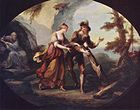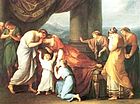- Angelica Kauffman
-
Angelica Kauffman 
Self-portrait by Angelica KauffmanBirth name Maria Anna Angelika Born 30 October 1741
Chur, Graubünden, SwitzerlandDied 5 November 1807
Rome, ItalyNationality Austrian Field Painting Movement Neoclassicism Maria Anna Angelika/Angelica Katharina Kauffman (30 October 1741 – 5 November 1807) was a Swiss-Austrian Neoclassical painter. Kauffman (not Kauffmann) is the preferred spelling of her name; it is the form she herself used most in signing her correspondence, documents and paintings.[1]
Contents
Life
Early years
She was born at Chur in Graubünden, Switzerland, but grew up in Schwarzenberg in Vorarlberg/Austria where her family originated. Her father, Joseph Johann Kauffman, was a relatively poor man but a skilled painter, who was often traveling for his work. It was he who taught his precocious daughter. Angelica rapidly acquired several languages from her mother, Cleophea Lutz, read incessantly and showed talent as a musician, but her greatest progress was in painting, and by her twelfth year she had become a notability, with bishops and nobles for her sitters.
In 1754 her father took her to Milan. Later visits to Italy of long duration followed. In 1763 she visited Rome, returning again in 1764. From Rome she passed to Bologna and Venice, everywhere feted for her talents and charm. Writing from Rome in August 1764 to his friend Franke, Winckelmann refers to her popularity. (She was then painting his picture, a half-length; of which she also made an etching.) She spoke Italian as well as German, he says, and expressed herself with facility in French and English - one result of the last-named accomplishment being that she became a popular portraitist for British visitors to Rome. “She may be styled beautiful,” he adds, “and in singing may vie with our best virtuosi.”
Years in Britain
 Troilus and Cressida, Act V, Scene II (1789), one of her many Shakespeare tableaux. Engraved in 1795 for an edition of Shakespeare by the Boydell Shakespeare Gallery.
Troilus and Cressida, Act V, Scene II (1789), one of her many Shakespeare tableaux. Engraved in 1795 for an edition of Shakespeare by the Boydell Shakespeare Gallery.
While at Venice, she was induced by Lady Wentworth, the wife of the British ambassador, to accompany her to London. One of her first works in London was a portrait of David Garrick, exhibited in the year of her arrival at “Mr Moreing's great room in Maiden Lane.” The rank of Lady Wentworth opened society to her, and she was everywhere well received, the royal family especially showing her great favor. Her firmest friend, however, was Sir Joshua Reynolds. In his pocket-book her name as “Miss Angelica” or “Miss Angel” appears frequently; and in 1766 he painted her, a compliment which she returned by her Portrait of Sir Joshua Reynolds. Another instance of her intimacy with Reynolds is to be found in her variation of Guercino's Et in Arcadia ego, a subject which Reynolds repeated a few years later in his portrait of Mrs Bouverie and Mrs Crewe.
When, in about November 1767, she was entrapped into a clandestine marriage with an adventurer who passed for a Swedish count (the Count de Horn), Reynolds helped extricate her, and it was doubtless owing to Reynolds's good offices that she was among the signatories to the petition to the king for the establishment of the Royal Academy. In its first catalog of 1769 she appears with “R.A.” after her name (an honor she shared with one other woman, Mary Moser); and she contributed the Interview of Hector and Andromache, and three other classical compositions.
 Kauffman (seated), in the company of other "Bluestockings" (1778)
Kauffman (seated), in the company of other "Bluestockings" (1778)
Her friendship with Reynolds was criticized in 1775 by fellow Academician Nathaniel Hone in his satirical picture The Conjurer. This attacked the fashion for Italianate Renaissance art, ridiculed Reynolds and included a nude caricature of Kauffman, later painted out by Hone. The work was rejected by the Royal Academy.
From 1769 until 1782 Kauffman was an annual exhibitor with the Royal Academy, sending sometimes as many as seven pictures, generally on classical or allegoric subjects. One of the most notable was Leonardo expiring in the Arms of Francis the First (1778).[2]
In 1773 she was appointed by the Academy with others to decorate St Paul's Cathedral; and it was she who, with Biagio Rebecca, painted the Academy's old lecture room at Somerset House.
History Painting
Kauffman's strength was her work in history painting, the most elite and lucrative category in academic painting during the 18th century. Under the direction of Sir Joshua Reynolds, the Academy made a strong effort to promote history painting to a native audience who were more interested in commissioning and buying portraits and landscapes. Despite the popularity that Kauffman enjoyed in British society and her success as an artist, she was disappointed by the relative apathy that the British had towards history painting. Ultimately she left Britain for the continent, where history painting was better established, esteemed, and patronized.
Later years in Rome
It is possible that her popularity declined as a consequence of her unfortunate marriage; but in 1781, after her first husband's death (she had been long separated from him), she married Antonio Zucchi (1728–1795), a Venetian artist then resident in Britain. Shortly thereafter she retired to Rome, where she befriended, among others, Johann Wolfgang von Goethe, who said she worked harder and accomplished more than any artist he knew; yet, always restive, she wanted to do more[3] and lived for 25 years with much of her old prestige.
In 1782, Kauffman's father died, as did her husband in 1795. She continued at intervals to contribute to the Royal Academy in London, her last exhibit being in 1797. After this she produced little, and in 1807 she died in Rome, being honored by a splendid funeral under the direction of Canova. The entire Academy of St Luke, with numerous ecclesiastics and virtuosi, followed her to her tomb in San Andrea delle Fratte, and, as at the burial of Raphael, two of her best pictures were carried in procession.
Legacy
The works of Angelica Kauffman have retained their reputation. By 1911, rooms decorated with her work were still to be seen in various quarters. At Hampton Court was a portrait of the duchess of Brunswick; in the National Portrait Gallery, a self-portrait (NPG 430). There were other pictures by her at Paris, at Dresden, in the Hermitage at St Petersburg, and in the Alte Pinakothek at Munich. The Munich example was another portrait of herself; and there was a third in the Uffizi at Florence. A few of her works in private collections were exhibited among the Old Masters at Burlington House.
Kauffman is also well known by the numerous engravings from her designs by Schiavonetti, Francesco Bartolozzi and others. Those by Bartolozzi especially found considerable favour with collectors.
Charles Willson Peale (1741–1827), artist, patriot, and founder of a major American art dynasty, named several of his children after notable European artists, including a daughter, Angelica Kauffman Peale.
Her biography was written in 1810 by Giovanni de Rossi. It has also been used as the basis of a romance by Léon de Wailly (1838) and it prompted the novel contributed by Anne Isabella Thackeray to the Cornhill Magazine in 1875 entitled “Miss Angel”.
Gallery
-
Death of Alcestis, 1741-1807.
-
A Sleeping Nymph Watched by a Shepherd , about 1780, Angelica Kauffman V&A Museum no. 23-1886
-
Scene from the 1802 première in Weimar of Goethe's "Iphigenia in Tauris, with Goethe himself as Orestes in the centre.
References
- ^ Wendy Wassying Roworth, ed. Angelica Kauffman: A Continental Artist in Georgian England. (London: Reaktion Books, 1992), 193.
- ^ King Francis I had become a close friend of Leonardo da Vinci during the artist's last years, and Vasari records that the King held Leonardo's head in his arms as he died. Aside from Kauffman, this story was portrayed in romantic paintings by Ingres, Ménageot and other French artists, though some historians consider it legend rather than fact.
- ^ Goethe, Italian Journey, 1786–1788
Further reading
 This article incorporates text from a publication now in the public domain: Henry Austin Dobson (1911). "Kauffmann, Angelica". In Chisholm, Hugh. Encyclopædia Britannica (11th ed.). Cambridge University Press.
This article incorporates text from a publication now in the public domain: Henry Austin Dobson (1911). "Kauffmann, Angelica". In Chisholm, Hugh. Encyclopædia Britannica (11th ed.). Cambridge University Press. "Kauffmann, Maria Angelica". The American Cyclopædia. 1879. This source reports she procured a divorce from the impostor Count Horn.
"Kauffmann, Maria Angelica". The American Cyclopædia. 1879. This source reports she procured a divorce from the impostor Count Horn.- Kauffmann, Angelica. (2001). "»Mir träumte vor ein paar Nächten, ich hätte Briefe von Ihnen empfangen«. Gesammelte Briefe in den Originalsprachen. Ed. Waltraud Maierhofer. Lengwil: Libelle, 2001. ISBN 978-3-909081-88-2 (Letters in German, English, Italian, French; introduction and commentary in German.)
- Kauffmann, Angelika. (1999) "Briefe einer Malerin." Ed. Waltraud Maierhofer. Mainz: Dieterich'sche Verlagsbuchhandlung.
- Natter, Tobias (ed.). "Angelica Kauffmann: A Woman of Immense Talent." Ostfildern: Hatje-Cantz, 2007. ISBN 978-3-7757-1984-1.
- Rosenthal, Angela. (2006). Angelica Kauffman: Art and Sensibility. New Haven, Connecticut: Yale University Press. ISBN 0300103336
External links
- Information Angelika Kauffmann in Schwarzenberg (GERMAN; also contains information and articles both in ENGLISH and ITALIAN)
- Vorarlberg Landesmuseum in Bregenz
- Index to the edition of her correspondence on the publisher's site
Categories:- 1741 births
- 1807 deaths
- People from Chur
- Swiss painters
- Royal Academicians
- Portrait artists
- Neoclassical painters
- British women artists
- Portraits of William Shakespeare
- 18th-century Swiss people
- Women painters
- Swiss women artists
Wikimedia Foundation. 2010.









